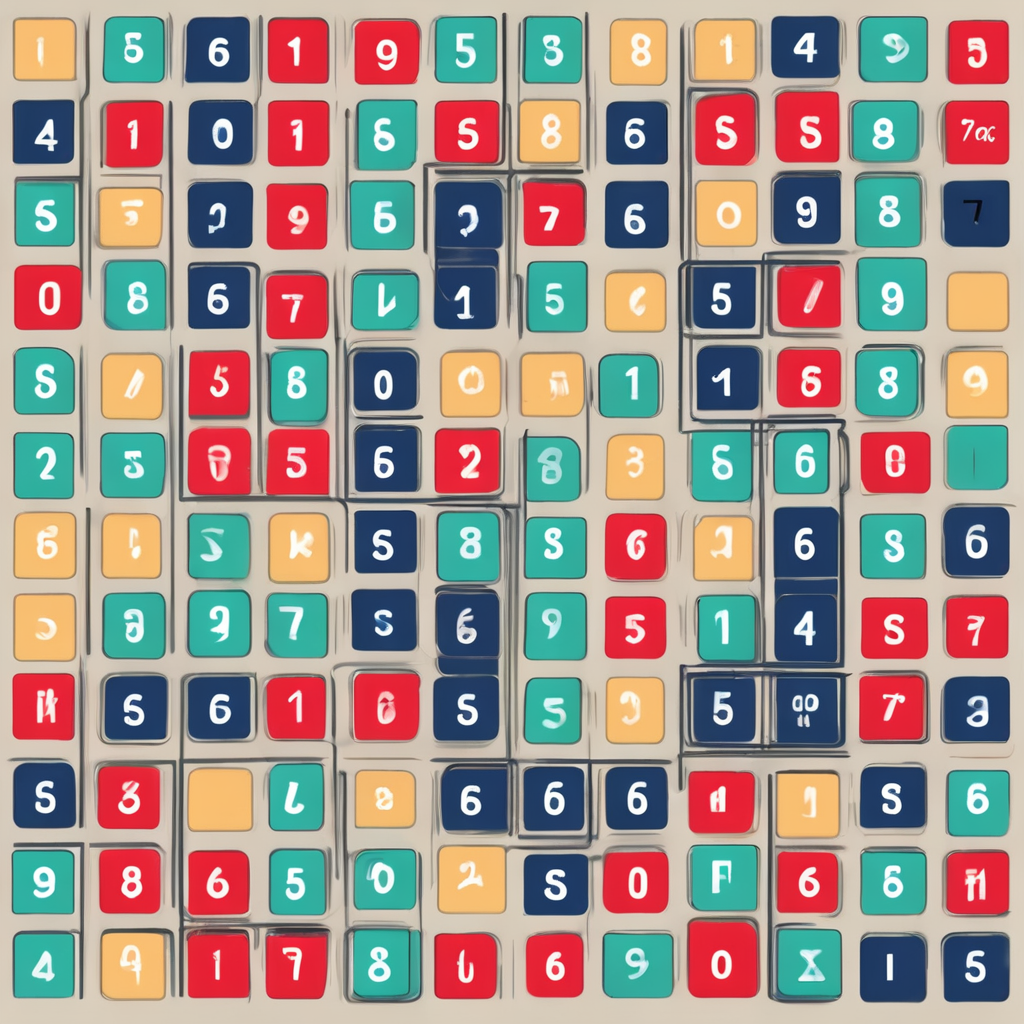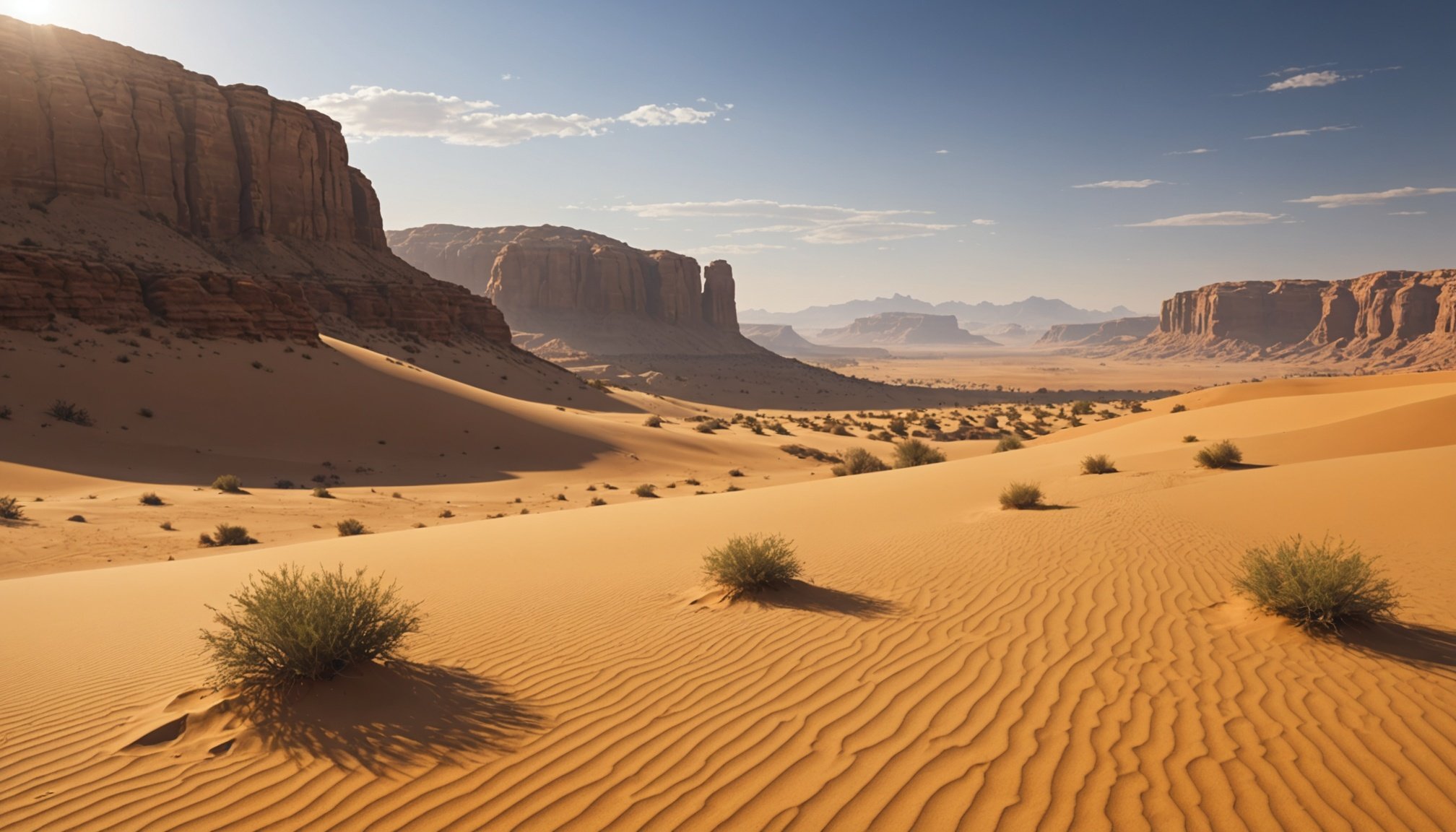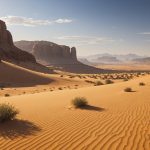Understanding the Basics of Desert Landscapes
Grasping the Desert Landscape Fundamentals is crucial for design accuracy and immersion. A desert environment is predominantly characterized by its arid climate, with high temperatures and minimal precipitation. Understanding these factors is essential for accurately creating such settings in any project. The geography of deserts often features vast stretches of sand dunes, rocky outcrops, and sparse vegetation.
The flora and fauna in desert landscapes play a significant role in defining the ecosystem. Common plant species include cacti and hardy shrubs that have adapted to survive with minimal water. Wildlife, such as reptiles, insects, and small mammals, are adapted to withstand extreme conditions. Recognizing these elements provides a basis for a more realistic integration of living components into desert-themed landscapes.
Also to read : Revamping Survival Games: Elevate Crafting with Real-World Physics for More Fun
Knowledge of these characteristics also aids in the strategic placement and design of game assets or geographic features. This insightful approach ensures engaging and credible additions to the project, be it for educational purposes or entertainment media. With a foundational understanding of these landscape fundamentals, creators can infuse creativity while maintaining the authenticity of a desert environment.
Essential Tools for Creating Desert Landscapes
In the realm of game development, crafting compelling desert landscapes requires a suite of tools that enhance creativity and efficiency. Software such as Unreal Engine, Unity, and Blender are highly valued for their versatile capabilities in landscape design. These platforms support the integration of essential plugins and assets that bring desert environments to life.
Also to see : Crafting Immersive Tactical Shooters: Tips for Developers to Elevate AI Enemy Realism
Popular plugins like World Machine and Gaia are pivotal in generating realistic terrains and textures. These programs allow developers to simulate sand dunes, rocky exteriors, and other key desert features.
When comparing workflow tools, productivity hinges on the seamless blending of capabilities. For instance, utilizing the asset management features of Quixel Megascans alongside the procedural generation capabilities of tools like Substance Designer can considerably enhance efficiency. This combination not only expedites the design process but also ensures the visual fidelity of the desert landscapes being created.
For developers invested in mastering desert environments, having a well-stocked toolkit is indispensable. Experimenting with different tools and workflows can unlock new creative avenues, enabling the crafting of captivating and authentic desert landscapes that engage and immerse players effectively.
Texturing Techniques for Sand and Rock Surfaces
Crafting realistic textures for sand and rock surfaces in game development requires keen attention to detail and deliberate technique selection. Effective texturing brings desert landscapes to life, ensuring visual accuracy and depth.
Techniques for Realistic Sand Simulation
Creating convincing sand surfaces can be achieved through dynamic texturing techniques. By simulating particle-based sand movement, developers can mimic natural sand patterns, enhancing immersion. Dynamic textures offer expression by reacting to environmental influences such as wind, enabling a more authentic representation.
Layering Textures
Layering is crucial for incorporating depth and complexity into desert landscapes. By overlaying various texture layers, developers can portray the intricacies of sand and rock formations. This technique allows for the representation of subtle surface variations, contributing to a nuanced and life-like environment.
Using Normal Maps for Depth
Normal maps add surface detail without increasing model complexity, ideal for both sand and rocks. These maps simulate small variations in surface height, providing detailed visual information about light interaction with textures. By using normal maps, developers can emphasize the ruggedness or softness of the environment, adding to its realism. Employing a variety of texture selections is fundamental for maintaining interest and ensuring landscapes appear diverse and authentic.
Lighting and Atmosphere in Desert Settings
Creating captivating desert environments depends significantly on the lighting techniques employed. The simulation of natural light is crucial, as it greatly influences the atmosphere and overall realism. Techniques such as dynamic sky systems can mimic sunlight’s movement, enhancing the landscape’s depth and texture perception. Incorporating realistic light diffusion effects can replicate the distinctive glow of desert sunrises and sunsets, essential for a credible scene.
Effects of Time of Day on Atmosphere
Desert settings experience stark changes as the day progresses, impacting the atmosphere significantly. During midday, intense sunlight creates sharp, contrasting shadows that define landscape elements. Conversely, dawn and dusk bring softer light, accentuating textures with longer shadows. Implementing these lighting variations can transform the user experience, reflecting the desert’s true essence.
Incorporating Environmental Effects
To enhance authenticity, environmental effects such as haze and drifting shadows should be considered. Haze can create a sense of great distance, characteristic of vast deserts, while shadows move with the sun, offering dynamic visual experiences. By utilizing these elements effectively, developers can evoke an atmosphere that is both immersive and realistic. Integrating these effects thoughtfully will engage players, making the desert landscape a vivid backdrop for exploration.
Creating Environmental Effects
Incorporating desert environmental effects elevates the realism in game simulations. Adding elements like dust storms enhances atmospheric depth, creating immersive experiences. Dust storms, with their swirling particles, obscure visibility and require meticulous detailing for authenticity.
Mirages are another crucial element that impacts player perception. They create illusions of water and distant objects. Simulating mirages requires precise manipulation of light refraction to capture their wavering visual characteristics.
Incorporating weather changes into gameplay introduces dynamic challenges and unpredictability. Varying conditions like sudden sandstorms demand adaptive strategies, fostering player engagement. To implement these effects, developers use animated techniques within game engines.
Techniques for animated effects, like particle systems, craft realistic storm movements and evolving landscapes. These systems allow for real-time adjustments, ensuring effects react naturally to player actions and environmental cues. Utilizing advanced shaders can improve visual fidelity, allowing for seamless transitions between weather states.
By mastering these techniques, developers can create a stunning array of environmental effects that heighten the gaming experience. Enhanced realism provides players with captivating environments that draw them into the heart of the desert, blending gameplay challenges with visual storytelling.
Case Studies of Successful Desert Landscapes in Games
Examining game landscape case studies offers valuable insights into the development of captivating desert environments. These case studies reveal key design decisions that contribute to successful and immersive gameplay experiences.
Analysis of Popular Adventure Games
Popular adventure games have set benchmarks for realistic and engaging desert landscapes. Studying these games provides a detailed understanding of how texture use, lighting effects, and environmental dynamics can create atmospheres that captivate players.
Key Design Decisions
Effective design choices, such as utilizing sophisticated texture layering or employing dynamic lighting, have proven crucial. These decisions enhance the realism and immersion of the desert setting, forming a cohesive and compelling landscape narrative.
Lessons Learned from Development
Reflecting on these case studies reveals practical strategies that can be applied to future projects. Lessons include balancing resource demands with performance, leveraging community feedback to refine environments, and embracing innovative approaches to storytelling through landscape design.
By learning from the successes and challenges of existing games, developers can replicate effective elements while pioneering new, creative directions in desert landscape design, ultimately enriching gameplay and player engagement.
Common Challenges in Desert Landscape Creation
Creating desert landscapes in game design presents unique challenges that require strategic thinking and problem-solving. Understanding these issues is essential for developers aiming to create visually stunning and immersive environments.
Addressing Issues of Scale and Depth Perception
One of the primary hurdles is achieving accurate scale and depth perception. Desert landscapes are vast, and the endless stretch of sand and sky can flatten the visual experience. Developers overcome this by strategically placing visual cues like distant mountains or scattered vegetation to create a sense of scale and depth.
Strategies for Maintaining Visual Variety
Maintaining visual variety is another challenge due to the inherently uniform nature of deserts. To combat monotony, designers employ varied textures, diverse flora profiles, and dynamic lighting to introduce subtle changes. This keeps the environment engaging and visually appealing.
Solutions for Performance Optimization in Large Environments
Large environments often strain system resources, affecting performance. Optimizing performance involves using level of detail (LOD) techniques, which adjust the complexity of object models based on the viewer’s distance, and efficient texture streaming. These strategies help maintain a seamless experience even in vast, detailed desert worlds. By addressing these challenges thoughtfully, developers ensure that desert landscapes are both beautiful and functionally robust.
Resources and Further Learning
Embarking on crafting desert landscapes in game development is an exciting yet challenging journey. To equip oneself with the necessary skills, engaging in recommended courses and tutorials is invaluable. Platforms like Udemy and Coursera offer courses tailored to landscape design, providing detailed insights into the techniques used in creating realistic environments. These resources help hone your skills by providing structured learning paths from experts.
Connecting with community forums and support groups, such as those on Discord or Reddit, allows developers to ask questions, share experiences, and gain feedback from a collective pool of knowledge. Joining game development communities fosters collaboration and keeps creators updated on industry trends and emerging techniques.
In addition to online courses and forums, exploring useful books and online materials can further deepen your understanding. Titles like “The Art of Game Design” or “Level Up! The Guide to Great Video Game Design” delve into the intricacies of landscape creation, providing both theoretical knowledge and practical examples.
By tapping into these resources, developers can continuously refine their craft, ensuring they stay at the forefront of game development and produce more engaging and visually stunning desert landscapes.











